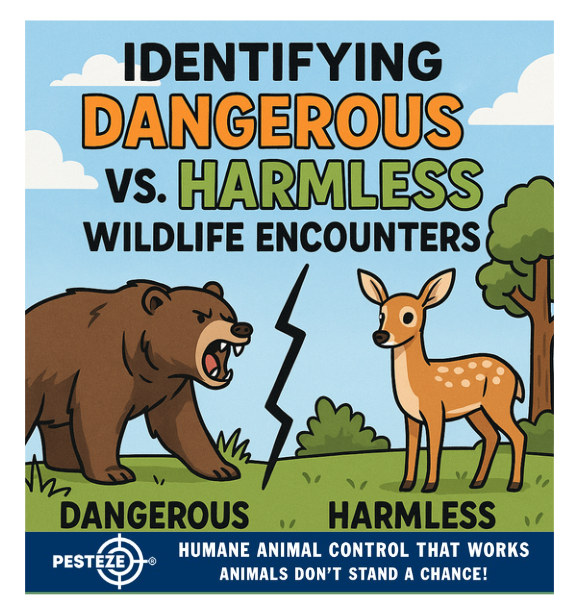IDENTIFYING DANGEROUS VS. HARMLESS WILDLIFE ENCOUNTERS

IDENTIFYING DANGEROUS VS. HARMLESS WILDLIFE ENCOUNTERS
SUMMARY
Not every wildlife encounter is dangerous—but knowing the difference can protect you, your pets, and the animals themselves. This guide explains how to recognize when wildlife encounters are harmless, when they pose risks, and the safest way to respond.
FEATURES
-
Harmless signs: Calm behavior, keeping distance, and no signs of aggression.
-
Dangerous signs: Growling, charging, or approaching directly.
-
Species awareness: Some animals are more likely to pose threats than others.
-
Day vs. night behavior: Time of encounter can indicate abnormal activity.
-
Protecting pets: How to recognize when your animals are at risk.
-
When to seek help: Knowing when to call wildlife authorities.
GUIDE DESCRIPTION
Encounters with wildlife are becoming more common as human development expands into natural habitats. While many animals pose little to no risk, others can be dangerous if startled, sick, or protecting their young. Understanding the difference between dangerous and harmless encounters helps you respond appropriately.
Harmless encounters are the most common. For example, spotting deer grazing at a distance, squirrels foraging in trees, or raccoons passing through your yard at night are generally safe situations. In these cases, the animals are not showing interest in humans, are behaving naturally, and will likely move on if left alone. The best response is to observe quietly and give them space.
Dangerous encounters, on the other hand, show warning signs. An animal approaching directly, growling, hissing, or baring teeth should be treated as a threat. Large predators such as coyotes, bears, or mountain lions can be especially dangerous if they lose their natural fear of humans. Even smaller animals, like raccoons or skunks, may be hazardous if they behave aggressively during the day, as this can be a sign of illness such as rabies.
Knowing the species involved is crucial. Snakes, for instance, can be harmless or venomous depending on the type. Birds may seem non-threatening, but large species like geese or swans can become aggressive if protecting nests. Recognizing the risks specific to each animal helps you decide whether to retreat, deter, or call for help.
Another factor is the time of day. Many nocturnal animals—like raccoons, foxes, or opossums—are harmless at night but may appear sick if active during daylight hours. Any wildlife showing unusual behavior should be treated with caution.
Pets often change the dynamics of wildlife encounters. Cats and dogs may provoke animals, increasing danger for both. If wildlife shows interest in or aggression toward pets, it’s best to remove your animals immediately and secure them indoors.
When in doubt, contact wildlife control authorities. If an animal is behaving aggressively, appears sick, or refuses to leave your property, professionals can step in safely and legally.
By learning to recognize harmless versus dangerous situations, you can protect yourself, your pets, and the wildlife around you.
- Saneeth Thota


Comments 0